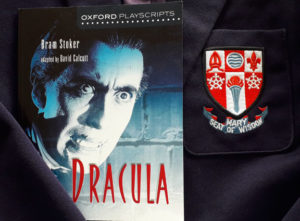Plot
 Jonathan Harker has travelled to Romania to help an aristocrat with some legal work. Once there, he is imprisoned in Count Dracula’s castle and soon realises the Count is actually some sort of monster. Meanwhile Dracula arrives in England, and starts to prey on fresh victims, including Jonathan’s fiancée, Mina, and her friend, Lucy.
Jonathan Harker has travelled to Romania to help an aristocrat with some legal work. Once there, he is imprisoned in Count Dracula’s castle and soon realises the Count is actually some sort of monster. Meanwhile Dracula arrives in England, and starts to prey on fresh victims, including Jonathan’s fiancée, Mina, and her friend, Lucy.
Authors – Bram Stoker and David Calcutt
Bram Stoker’s stage adaptation of Dracula
Discover more about Bram Stoker
|
Themes – universal ideas
Good and evil, love, modern vs traditional, religion, role of women, strangers, science vs superstition.
More to explore – motifs, symbols, context, setting
Asylums, bats, black dogs, blood and transfusion, Carpathians, castles, crucifixes, diaries, escape, garlic, hypnosis, letters, mental health, mirrors, mist, night, predators and prey, prisoners, secrets, sleepwalking, St George’s Day, Transylvania, vampires, vermin, Victorian period, Whitby, William Blake.
Did you know?
When Jonathan Harker travels to Transylvania, he is going to a real place. Transylvania is an area of Romania in eastern Europe. The town mentioned by Harker, Bistritz, is now called Bistrița.
When Bram Stoker sent Dracula to his publisher, he wanted to present it as a true story. The publisher said it would cause panic and refused. It was eventually published on May 26th 1897, which is now #WorldDraculaDay.
Further reading
Discover these titles and more
|
If you enjoyed this dramatisation of Dracula, try these titles:
The Saga of Darren Shan follows the adventures of a human teenager forced to work for a vampire. Library copies available.
Sarah Midnight Trilogy by Daniela Sacerdoti is set in Scotland and Poland, with a teenage girl struggling to accept her gift for hunting demons. Library copies available.
Riverkeep by Martin Stewart. Wull’s father has been possessed by an evil spirit. It’s up to Wull to hunt down a potential cure. Library copies available.
Through the Woods by Emily Carroll is a graphic novel of creepy short stories. Library copy available.
The Vampire Handbook by Robert Curran is a non-fiction book explaining the myths about vampires from around the world, and a guide to protecting yourself, just in case. Library copy available.
Try the original book of Dracula by Bram Stoker. Library copy available. You can also download a free copy or read it online.
The real history in Bram Stoker’s Dracula (Time Magazine)
Literacy and Language
Dracula is an example of Gothic Literature.
(The video above may not be visible in school.)
The original story is not written like a normal novel, but through diaries, letters, telegrams and reports. This allows several narrators to tell the story from their own point of view.
Renfield quotes a poem by William Blake called Auguries of Innocence. You can read the whole poem here.
Numeracy
Are vampires good at Maths?
Well, no. Not unless you Count Dracula! Don’t forget he is a vamΠre.
Did you know Bram Stoker mentions the number 3 more than 50 times in the original novel? How many can you spot in the dramatised version?
Do you think there is a reason for the number 3 or is it just a coincidence?
Health and Wellbeing
Characters mention peace of mind in the script a few times. What does that mean to you? Do you think the characters ever had real peace of mind again?
Some writers believe that vampires were inspired by real life illnesses from times before medical understanding. You can read about some examples here.
Rights Respecting Schools
Article 6 says that every child has the right to life.
Wonder what the vampires think about that …?
Developing the Young Workforce
 The protagonists in Dracula are fighting a supernatural monster, and they are successful in their plans eventually, but at a cost.
The protagonists in Dracula are fighting a supernatural monster, and they are successful in their plans eventually, but at a cost.
If you wanted to get rid of a vampire, which of the characters would you employ and why?


